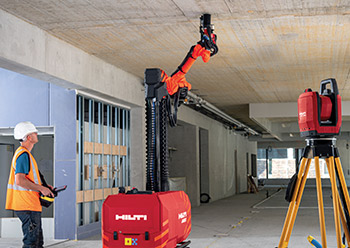
Jaibot is navigated by a worker via remote control and uses reference data from the robotic Hilti PLT 300 total station.
Jaibot knows the drill!
Hilti has developed a semi-autonomous mobile drilling robot that is designed to make mechanical, electrical and plumbing installation work easier, faster and safer – and has already proved its mettle at a landmark project in Dubai.
01 February 2021
Jaibot, a semi-autonomous mobile drilling robot introduced by Hilti, a Liechtenstein-based construction solutions provider, has already been creating waves in the region with its successful deployment on its pilot project in the UAE – the mixed-use One Za’abeel project in Dubai.
Launched globally last October and in the UAE on January 1, 2021, the Hilti Jaibot is designed to help MEP (mechanical, electrical and plumbing) installation and IF (interior fininish) contractors tackle productivity, safety and labour shortage challenges. In addition, with this new robotic solution, Hilti helps in pushing towards the digitalisation of construction sites.
“The Jaibot proves to be yet another breakthrough innovation from Hilti using robotic technology for faster, safer and more accurate execution of overhead drilling,” Hussam Droubi, Head of Marketing and Engineering with Hilti Emirates, tells Gulf Construction.
 |
|
Jaibot, a semi-autonomous drilling robot. |
“Many major contractors have expressed a keen interest in having the Jaibot work on some of their strategic projects. The Hilti Jaibot will change the way contractors work by driving change management to move towards the IoT (Internet of Things). This is just the beginning! Hilti will continue to develop digitalised solutions to help the construction industry adapt to the new changing environment,” he adds.
The Jaibot is designed for mechanical, electrical, plumbing and interior finishing installation work. With a completely cordless system that can work for up to eight hours between charges and a built-in dust removal system, the Jaibot is an easy-to-use drilling robot that does not require expert skills, according to Hilti.
The Jaibot executes its tasks based on building information modeling (BIM) data. A semi-automated drilling technology, the Hilti Jaibot helps boost productivity on installation projects. This innovative construction robot takes over installation execution, while allowing the user to track project progress and status through data. Using digital plans, the Jaibot marks and drills holes, relieving construction workers from the strenuous task of overhead drilling, the company says.
To automate the jobsite with Jaibot, the BIM data should be uploaded from Autocad or Revit to the Hilti Cloud; the jobfile imported via the rugged field tablet PLC 400 for layout applications; and the jobsite located with the Hilti total station PLT 300. Jaibot will then drill all holes within its range autonomously according to the digital drilling plan, resulting in higher drilling accuracy due to a digitised process, Hilti adds.
The new tool addresses the issues faced with productivity of the construction industry, which has been lagging behind other sectors for years.
 |
|
Using digital plans, the Jaibot marks and drills holes, relieving workers from the task of overhead drilling. |
“Margin pressure and shortages of skilled labour are already facts of life in our industry and make it increasingly difficult to overcome productivity shortfalls,” Jan Doongaji, Member of the Executive Board, Hilti Group, notes. “But leveraging the opportunities offered by digitalisation will compensate for it. We do this by intelligently linking processes, teams and data. With Jaibot, and in close collaboration with our customers, we are further stepping toward realising the efficiency that digital transformation can and will bring to construction sites.”
Significant productivity gains are possible with digitally planned construction projects and their realisation with the help of robotic solutions. “BIM-enabled robotic solutions also make the construction process more transparent with improved execution speed, constant performance and fewer errors. Daily progress can be reported from the field to the project office via cloud computing. Potential conflicts between the trades involved on a jobsite also can be detected at an early stage and then limited, resulting in more projects delivered on-time and within budget,” he says.
Safety played an important role in the development of the Jaibot. It is designed to assist tradespeople in physically demanding, repetitive installation tasks such as drilling numerous holes overhead for many mechanical, electrical or plumbing installations. It is navigated by the worker via remote control and uses reference data from the robotic Hilti PLT 300. Holes within reach are drilled automatically, says Julia Zanona, Product Manager for Robotics at Hilti.
“We looked at which routine work on the construction site is among the most stressful, and that is primarily overhead work,” Zanona continues. “From the beginning, it was important to us to develop a robotic solution that supports our customers where it is most needed. The Hilti Jaibot takes over the most strenuous and exhausting tasks, working alongside the installation team.”
In the UAE, Alec, one of the country’s leading construction groups, has collaborated with Hilti to pilot Jaibot. Alec has been working with Hilti since March 2019 to test the robot’s productivity on a number of its projects, including One Za’abeel, where it is engaged as the main contractor.
Kez Taylor, CEO of Alec, says: “It is incredibly exciting to witness the transformation of the construction industry up close through our collaboration with Hilti. We are passionate about continually championing innovation and digital transformation in the industry, and via Jaibot, we can see how the future of construction is shaped, whilst unlocking new levels of efficiency in our processes.”
The Hilti Jaibot is available on a daily rental basis in the UAE.
- Jaibot knows the drill!
- Pre-clad ductwork offers cost savings
- Becon keeps a close watch on HVAC systems
- Sawafi Borets breaks ground on hub at Spark
- Flovac systems to tackle Qatar resort challenge


